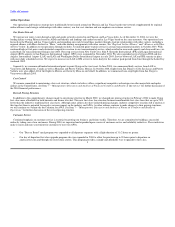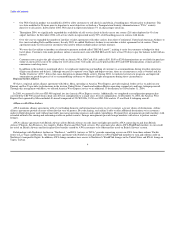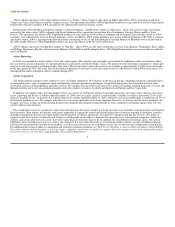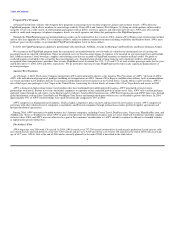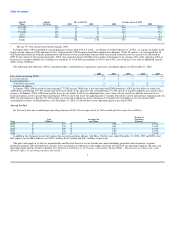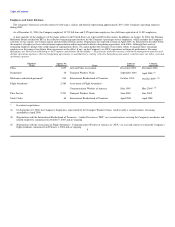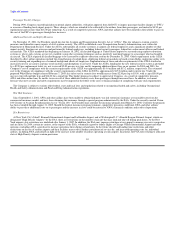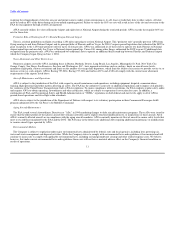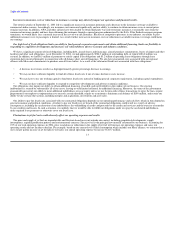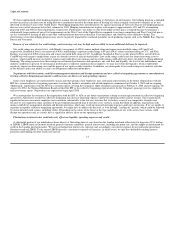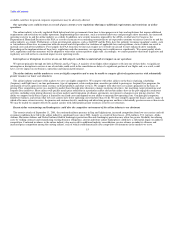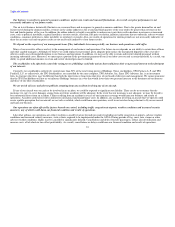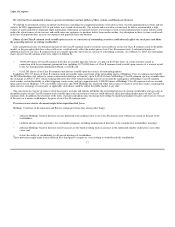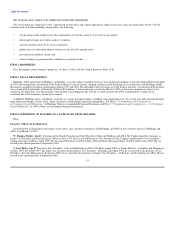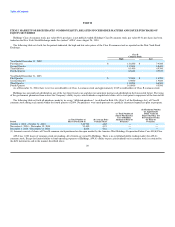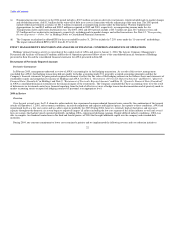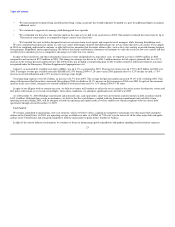US Airways 2004 Annual Report Download - page 16
Download and view the complete annual report
Please find page 16 of the 2004 US Airways annual report below. You can navigate through the pages in the report by either clicking on the pages listed below, or by using the keyword search tool below to find specific information within the annual report.
Table of Contents
Increases in insurance costs or reductions in insurance coverage may adversely impact our operations and financial results.
The terrorist attacks of September 11, 2001 led to a significant increase in insurance premiums and a decrease in the insurance coverage available to
commercial airline carriers. Accordingly, our insurance costs increased significantly and our ability to continue to obtain insurance even at current prices
remains uncertain. In addition, AWA and other airlines have been unable to obtain third party war risk (terrorism) insurance at reasonable rates from the
commercial insurance market and have been obtaining this insurance through a special program administered by the FAA. If the Federal insurance program
terminates, we would likely face a material increase in the cost of war risk insurance. Because of competitive pressures in our industry, our ability to pass
additional insurance costs to passengers is limited. As a result, further increases in insurance costs or reductions in available insurance coverage could harm
our earnings.
Our high level of fixed obligations limits our ability to fund general corporate requirements and obtain additional financing, limits our flexibility in
responding to competitive developments and increases our vulnerability to adverse economic and industry conditions.
We have a significant amount of fixed obligations, including debt, aircraft leases and financings, aircraft purchase commitments, leases of airport and other
facilities and other cash obligations. As of December 31, 2004, we had approximately $786.3 million of outstanding debt, of which $186.0 million was
secured. In addition, we had $8.5 million of payments to satisfy capital lease obligations and $3.2 billion of operating lease obligations through lease
expiration dates incurred primarily in connection with off-balance sheet aircraft financings. We also have guaranteed costs associated with our regional
alliance with Mesa and commitments to purchase aircraft from Airbus. As a result of the substantial fixed costs associated with these obligations:
• A decrease in revenues results in a disproportionately greater percentage decrease in earnings.
• We may not have sufficient liquidity to fund all of these fixed costs if our revenues decline or costs increase.
• We may have to use our working capital to fund these fixed costs instead of funding general corporate requirements, including capital expenditures.
• We may not have sufficient liquidity to respond to competitive developments and adverse economic conditions.
Our obligations also impair our ability to obtain additional financing, if needed, and our flexibility in the conduct of our business. Our existing
indebtedness is secured by substantially all of our assets, leaving us with limited collateral for additional financing. Moreover, the terms of the government
guaranteed loan restrict our ability to incur additional indebtedness or issue equity unless we use the proceeds of those transactions to repay the loan, require
prepayment if our employee compensation costs exceed a certain threshold, require us to maintain a minimum cash balance of $100 million, and restrict our
ability to take certain other actions, including mergers and acquisitions, investments and asset sales.
Our ability to pay the fixed costs associated with our contractual obligations depends on our operating performance and cash flow, which in turn depend on
general economic and political conditions. A failure to pay our fixed costs or breach of the contractual obligations could result in a variety of adverse
consequences, including the acceleration of our indebtedness, the withholding of credit card proceeds by the credit card servicers and the exercise of remedies
by our creditors and lessors. In such a situation, it is unlikely that we would be able to fulfill our obligations under or repay the accelerated indebtedness,
make required lease payments or otherwise cover our fixed costs.
Fluctuations in jet fuel costs could adversely affect our operating expenses and results.
The price and supply of jet fuel are unpredictable and fluctuate based on events outside our control, including geopolitical developments, supply
interruptions, regional production patterns and environmental concerns. Since jet fuel is the principal raw material consumed by our business, accounting for
23% of our total operating expenses in 2004, price escalations or reductions in the supply of jet fuel will increase our operating expenses and cause our
operating results and net income to decline. For example, based on our current level of fuel consumption which includes our Mesa alliance, we estimate that a
one-cent per gallon increase in jet fuel prices will cause our annual operating expense to increase by $5.7 million.
13


